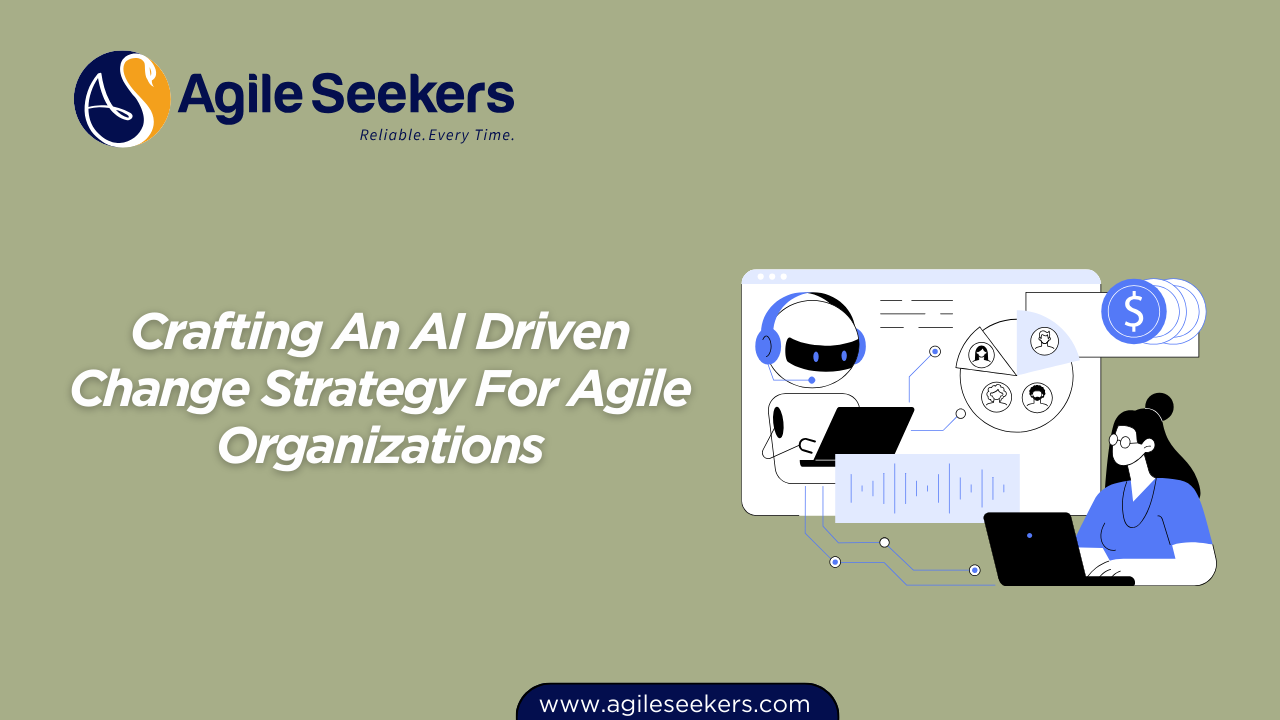Crafting An AI Driven Change Strategy For Agile Organizations

Shifting an organization toward agility isn’t just about new ceremonies or tools. It’s about changing how people think, decide, and deliver value.
Adding AI into that equation raises the stakes — and the potential — because it can help leaders see patterns earlier, automate repetitive work, and make better-informed decisions. But to get those benefits, you need a deliberate, AI-driven change strategy.
1. Start with Why AI Belongs in Your Change Strategy
AI isn’t a shiny add-on. It’s a force multiplier for agile change because it can:
-
Spot inefficiencies and bottlenecks in delivery pipelines.
-
Give leaders predictive insights into risks and dependencies.
-
Personalize communication and learning for teams going through change.
-
Support data-driven prioritization instead of gut-feel decision-making.
The point isn’t to replace people’s judgment but to help them make faster, smarter calls. Without a clear “why,” AI adoption risks turning into a disconnected pilot program.
2. Anchor AI to Agile Principles
If AI starts dictating processes, you’ll lose agility. Instead, frame your AI adoption through the lens of Agile principles:
-
Customer value first – Use AI to surface the work that will have the highest impact, not just what’s easiest to deliver.
-
Transparency – Make AI-generated insights visible and explainable so people can trust them.
-
Continuous learning – Treat AI models as experiments. Measure accuracy, gather feedback, and refine.
By aligning AI initiatives to Agile values, you ensure they accelerate agility rather than create a new layer of bureaucracy.
3. Map the Change Journey
A good change strategy blends vision with a roadmap. For an AI-driven approach:
-
Current state analysis – Use AI-powered analytics to assess delivery flow, quality metrics, and team sentiment.
-
Future state vision – Define what “AI-enabled agility” looks like for your organization, with measurable outcomes.
-
Gap analysis – Identify skills, tools, and cultural shifts needed.
-
Prioritized backlog – Treat your change plan like a product backlog, with the highest-value change items delivered first.
This approach makes the transformation tangible and measurable rather than a vague “culture change.”
4. Build AI Awareness and Skills
Technology adoption fails when people feel it’s imposed on them. Invest in education and skill-building:
-
Intro sessions on AI basics for all roles.
-
Deep-dive training for change agents and agile leaders.
-
Hands-on workshops where teams experiment with AI tools in safe environments.
If you’re looking for structured learning in this space, programs like AI for Agile Leaders & Change Agents Certification can help leaders design and guide AI-powered transformations with confidence.
5. Use AI to Drive Stakeholder Engagement
Stakeholders often lose interest when change feels abstract. AI can change that:
-
Sentiment analysis on feedback channels to detect early resistance.
-
Predictive engagement models to flag when communication frequency or content needs adjusting.
-
AI-generated visuals to make complex change metrics easier to grasp.
By showing real-time progress, you keep stakeholders involved and reduce the risk of late-stage surprises.
6. Embed AI into Agile Rituals
Rather than making AI another dashboard people ignore, weave it into existing agile events:
-
Sprint Planning – Use AI to estimate capacity, highlight dependencies, and suggest priority shifts based on real-time data.
-
Daily Standups – AI summaries of blockers and risks from team tools help keep conversations focused.
-
Retrospectives – AI-driven analysis of performance metrics can trigger richer discussions about improvement.
This integration keeps AI insights actionable and relevant.
7. Pilot, Learn, Scale
Avoid rolling out AI organization-wide from day one. Start with:
-
A small pilot in a willing team or portfolio.
-
Clear success criteria — both quantitative (cycle time reduction) and qualitative (team satisfaction).
-
Feedback loops to refine models and processes before scaling.
Document lessons learned and build a playbook for wider adoption.
8. Manage Risks and Ethics
AI adds new dimensions to change management risk:
-
Data privacy – Ensure compliance with local and industry regulations.
-
Bias – Regularly audit AI outputs for unintended bias.
-
Explainability – Don’t implement “black box” systems; users should understand how outputs are generated.
Ethics isn’t a box-ticking exercise — it’s a core trust factor in adoption.
9. Measure Change Impact with AI
You can’t improve what you don’t measure. AI makes it easier to:
-
Track adoption rates across teams.
-
Analyze productivity trends over time.
-
Correlate training completion with performance metrics.
-
Identify high-impact change actions through pattern recognition.
This turns change management into a data-driven discipline rather than a subjective process.
10. Keep Humans in the Loop
AI can inform decisions, but people decide. The most successful AI-driven change strategies keep human judgment at the center, with AI as a supporting partner.
Final Thoughts
Crafting an AI-driven change strategy for Agile organizations is about weaving intelligent tools into every stage of the transformation — without losing sight of the human and cultural factors that make agility thrive. It’s a balance of vision, experimentation, and grounded execution.
When done right, AI doesn’t just make change faster. It makes it smarter, more measurable, and more sustainable.
Also read - How PMOs And RTEs Can Benefit From AI In Leadership Roles
Also see - How AI Supports Leadership Decisions In Agile Enterprises




















